Plants



Aglaonema 4 Alocasia 8 Araucaria 10 Areca 12 Bucida 14 Bulnesia 16 Caryota 18 Chamaedorea 20 Clusia 22 Croton (Codiaeum) 24 Cycas 26 Dicksonia 28
Dieffenbachia 30 Dracaena 32 Ficus 36 Licuala 40 Liriope 42
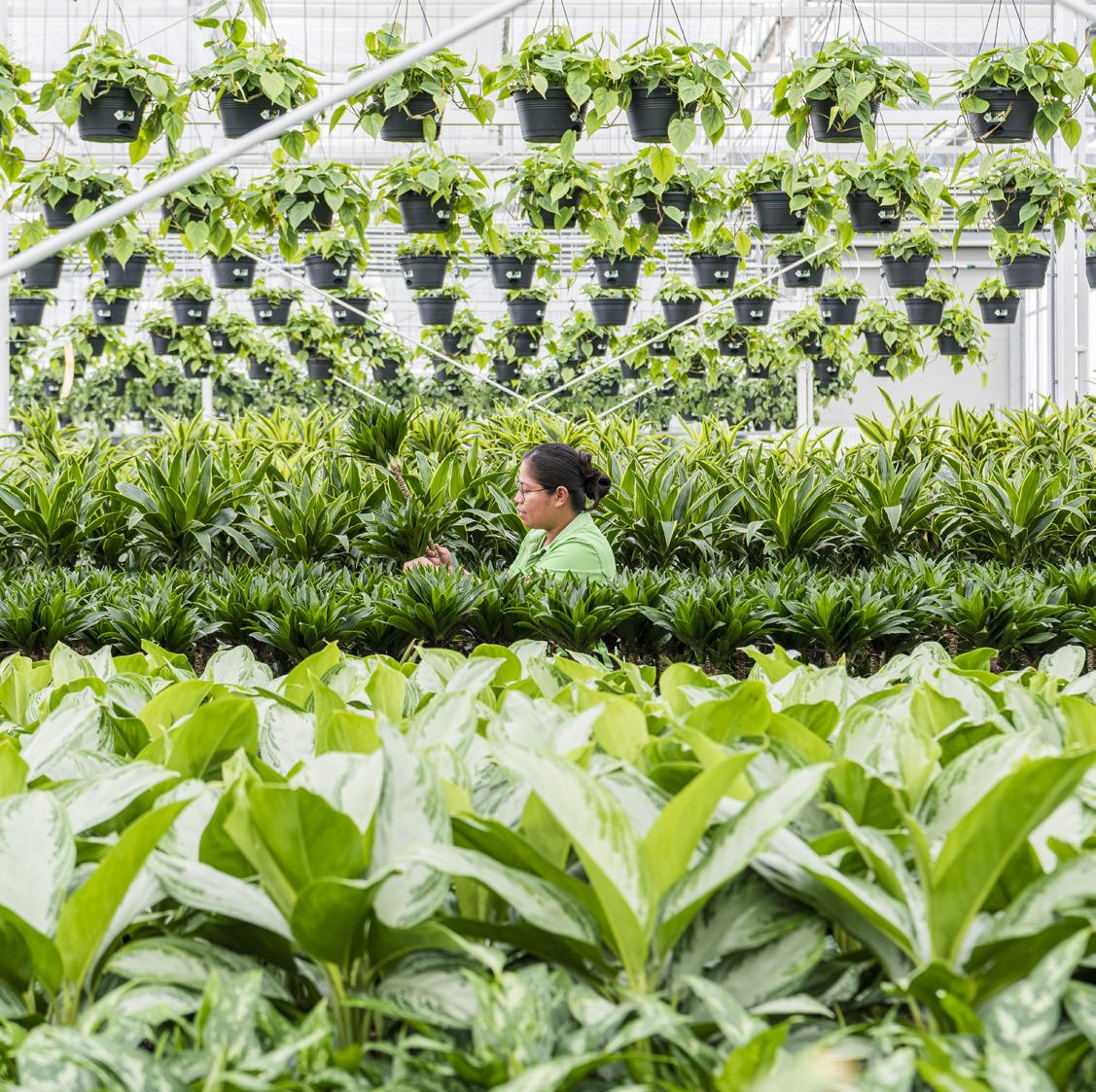
Monstera 44 Musa 46 Pandanus 48 Philodendron 50
Platycerium 54 Pleomele (Dracaena) 56 Podocarpus 58 Rhapis 60 Sansevieria 62 Satakentia 66 Schefflera 68 Scindapsus 70 Strelitzia 72 Veitchia (Adonidia) 74 Washingtonia 76 Webshop 79


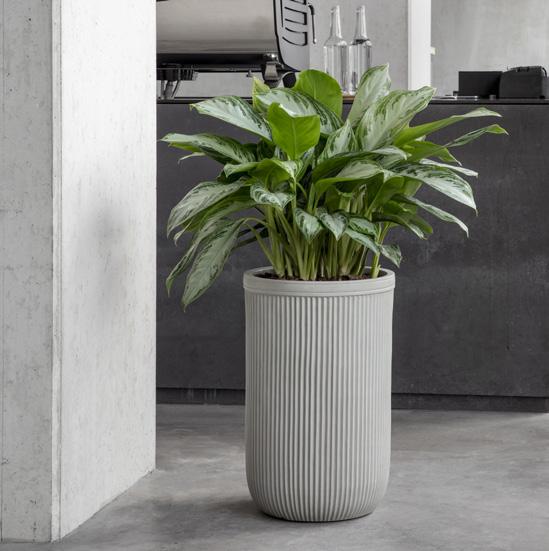

De Aglaonema komt voor in de tropische regenwouden van Oost-Azië. In hun natuurlijke leefomgeving groeien deze planten op vochtige, schaduwrijke plekken onder het bladerdek van grotere planten en bomen. De meeste variëteiten hebben bonte bladeren met een gestreept of gevlekt patroon. Dit soort is gemakkelijk in onderhoud en hierdoor ook ideaal voor kantoorbeplanting.
Die Aglaonema kommt in den tropischen Regenwäldern Ostasiens vor. In ihrer natürlichen Umgebung wachsen diese Pflanzen auf feuchten, gut beschatteten Plätzen unter dem Blätterdach größerer Pflanzen und Bäume. Die meisten Arten besitzen bunte Blätter mit einem Streifen- oder Fleckenmuster. Diese Sorte ist pflegeleicht und dadurch auch ideal für die Bürobegrünung geeignet.
The Aglaonema is indigenous to the tropical rain forests of East Asia. In their natural habitat, these plants grow in moist, shaded areas under the canopy of larger plants and trees. Most varieties have variegated leaves with a striped or pinnate pattern. This plant species is easy to care for and ideal for use in offices.
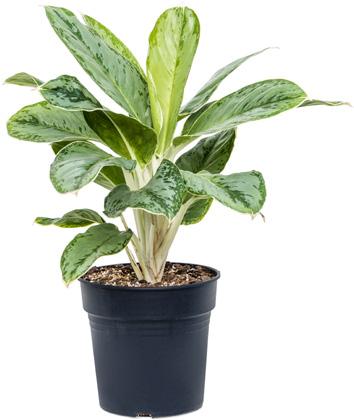
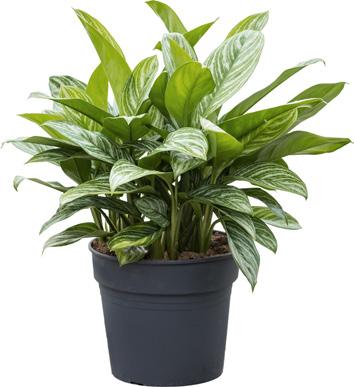

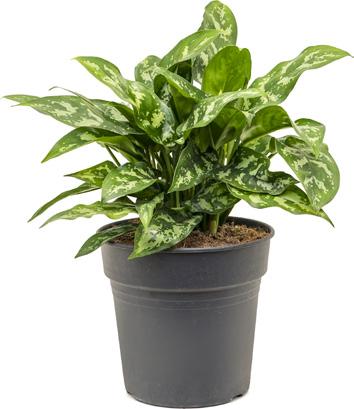

L’Aglaonema provient des forêts tropicales humides de l’Asie de l’Est. Dans leur cadre naturel, ces plantes poussent dans des endroits humides et ombragés, sous le feuillage de plantes et d’arbres plus grands. La plupart des variétés ont un feuillage panaché avec un motif rayé ou tacheté. Cette espèce est facile à entretenir et donc idéale pour les plantations dans les bureaux.








De Alocasia komt oorspronkelijk uit de tropische regenwouden van Zuidoost-Azië, met name uit Borneo en India. Hier kan de plant wel 4 meter hoog worden. De Alocasia behoort tot de Araceae familie (Aronskelk) die uit negenenzeventig soorten bestaat. Alocasia's zijn niet de makkelijkste interieurplanten in onderhoud. Ze behoren echter tot de meest decoratieve planten die er bestaan en zijn daarmee absoluut de inspanning waard.






Die Alocasia stammt ursprünglich aus den tropischen Regenwäldern Südostasiens, insbesondere aus Borneo und Indien. Hier kann die Pflanze bis zu 4 Meter hoch werden. Die Alocasia gehört zur Familie der Aronstabgewächse (Araceae), die aus 79 Arten besteht. Alocasias sind nicht die pflegeleichtesten Zimmerpflanzen. Sie gehören jedoch zu den dekorativsten Pflanzen, die es gibt und sind daher die Mühe absolut wert.
Alocasia is native to the tropical rainforests of Southeast Asia, particularly Borneo and India. Here the plant can grow up to 4 metres high. Alocasias belong to the Araceae (Arum) family, which consists of seventy-nine species. Alocasias are not the easiest of interior plants to care for. However, they are among the most decorative plants in existence and are therefore well worth the effort.

L'Alocasia est originaire des forêts tropicales humides d'Asie du Sud-Est, en particulier de Bornéo et de l'Inde. La plante peut y atteindre une hauteur de 4 mètres. L'Alocasia appartient à la famille des Araceae (Arum) qui compte soixante-dix-neuf espèces. Les alocasias ne sont pas les plantes d'intérieur les plus faciles. Cependant, elles font partie des plantes les plus décoratives qui existent et vos efforts seront donc bien récompensés.
De Araucaria stamt af van een eeuwenoude plant genaamd Araucarioxylon arizonicum. Deze oerplant komt uit het Trias tijdperk zo’n 60 miljoen jaar geleden. De plant komt van oorspronkelijk voor in gebieden op het zuidelijke halfrond. Deze naaldboom heeft stevige groengrijze bladeren die prikkend kunnen aanvoelen.





Die Araucaria ist Nachkomme einer uralten Pflanze namens Araucarioxylon arizonicum. Diese Urpflanze entstammt dem Erdzeitalter Trias vor rund 60 Millionen Jahren. Die Pflanze hat ihren Ursprung in Gebieten auf der südlichen Halbkugel. Dieser Nadelbaum besitzt dicke, graugrüne Blätter, die an der Haut brennen können.
The Araucaria is a descendant of an ancient plant called Araucarioxylon arizonicum. This primaeval plant is from the Triassic age, almost 60 million years ago. The plant originated in countries in the southern hemisphere. This pine tree has firm leaves in a green to grey colour that can sting to the touch.


L’Araucaria descend d’une ancienne plante appelée Araucarioxylon arizonicum. Cette plante primitive est issue de la période du Trias, il y a environ 60 millions d’années. La plante vient à l’origine de régions de l’hémisphère sud. Ce conifère a des feuilles vertes-grises solides qui peuvent être piquantes.
De Dypsis, beter bekend als Areca palm, komt oorspronkelijk van het Afrikaanse eiland Madagascar, maar is ook te vinden in kunstgebieden van Zuidoost-Azië. Met zijn smalle, geveerde bladeren zorgt deze palm voor een tropische uitstraling in het interieur.
Die Dypsis, besser bekannt als Areca-Palme, stammt ursprünglich von der afrikanischen Insel Madagaskar, ist aber auch in den Küstenregionen Südostasiens anzutreffen. Mit ihren schmalen, gefiederten Blättern sorgt diese Palme für eine tropische Stimmung im Raum.

The Dypsis, also known as the Areca plant, is native to the African island of Madagascar, but can also be found in coastal regions of Southeast Asia. With its narrow, pinnate leaves, this palm brings a tropical atmosphere to any interior space.







Le Dypsis, plus connu sous le nom de palmier Areca, est originaire de l’île africaine de Madagascar, mais pousse également dans les zones côtières de l’Asie du Sud-Est. Avec ses feuilles étroites et pennées, ce palmier donne un aspect tropical à l’intérieur.
De Bucida buceras 'Shady Lady' is een tropische boom, met een inheemse uitstraling. Deze unieke eigenschap maakt de boom zeer populair in vele beplantingsprojecten, omdat u daarmee de sfeer van buiten naar binnen haalt. De Bucida buceras komt oorspronkelijk voor in natte bossen en gedijt het best in een vochtige, goed doorlatende bodem. De boom laat dagelijks bladeren vallen.

Die Bucida buceras 'Shady Lady' ist ein tropischer Baum mit heimischer Ausstrahlung. Durch diese ganz besondere Eigenschaft ist der Baum bei Begrünungsprojekten sehr beliebt, denn er bringt Freiluftatmosphäre in die Innenräume. Die Bucida buceras wuchs ursprünglich in Feuchtwäldern und gedeiht am besten auf feuchtem, durchlässigem Boden. Der Baum wirft täglich Laub ab.



The Bucida buceras 'Shady Lady' is a tropical tree with an indigenous look. Thanks to this unique quality, the tree is a popular tree to plant because this tree helps bring the outdoors indoors. The Bucida buceras is native to wet forests and thrives in a moist, permeable soil. The tree drops leaves every day.



Le Bucida buceras 'Shady Lady' est un arbre tropical, à l’apparence indigène. Grâce à cette caractéristique unique, l’arbre est très populaire dans de nombreux projets de plantation, car il permet de créer une ambiance d’extérieur à l’intérieur. Le Bucida buceras vient à l’origine des forêts humides et sa croissance est optimale dans une terre humide et bien drainée. L’arbre perd ses feuilles au quotidien.
De Bulnesia komt van oorsprong uit Colombia en Venezuela. Het is een langzaam groeiende en groenblijvende boom met klein, ovaal en lichtgroen geveerd blad. De Bulnesia vraagt een lichte, zonnige plek en is bestand tegen lichte vorst. De Bulnesia stelt geen hoge eisen aan de grond, zolang deze maar goed draineert en de grond licht vochtig is. Bij bloei geeft de boom kleine sierlijke gele bloemen.



Die Bulnesia stammt ursprünglich aus Kolumbien und Venezuela. Es handelt sich um einen langsamwüchsigen, immergrünen Baum mit kleinen, ovalen und hellgrün gefiederten Laubblättern. Die Bulnesia benötigt einen hellen, sonnigen Standort und verträgt leichten Frost. Sie stellt keine hohen Ansprüche an den Boden, solange Wasser gut abgeleitet wird und eine geringe Feuchtigkeit erhalten bleibt. Zur Blütezeit bilden sich kleine, zierliche gelbe Blumen.
The Bulnesia is originally from Colombia and Venezuela. This is a slow-growing evergreen tree with a small, oval-shaped and light-green pinnate leaf. The Bulnesia needs a light, sunny place and is can withstand a light frost. The Bulnesia does not make high demands on the soil as long as it drains well and is slightly moist. When the tree blooms you see small, elegant yellow flowers.




Le Bulnesia est originaire de Colombie et du Venezuela. C’est un arbre à croissance lente et à feuillage persistant avec de petites feuilles ovales et pennées vert clair. Le Bulnesia a besoin d’un endroit lumineux et ensoleillé, et peut supporter une légère gelée. Le Bulnesia n’est pas très exigeant pour la terre, à condition qu’elle soit bien drainée et légèrement humide. Lors de la floraison, l’arbre donne de petites fleurs jaunes décoratives.

De Caryota is een palm die oorspronkelijk voorkomt in Azië en Australië. De geveerde, driehoekige bladeren lijken op een beetje op een vissenstaart. De bijzondere bladeren geven deze palm een karakteristiek uiterlijk.

Die Caryota ist eine Palme, die ursprünglich in Asien und Australien verbreitet war. Die gefiederten, dreieckigen Blätter ähneln einem Fischschwanz. Die besonders geformten Blätter machen aus dieser Palme eine charakteristische Erscheinung.
The Caryota is a palm tree originally home to Asia and Australia. The triangular pinnate leaves are reminiscent of a fish tail. These extraordinary leaves give this palm tree a distinctive look.






Le Caryota est un palmier originaire d’Asie et d’Australie. Les feuilles pennées et triangulaires ressemblent à la queue d’un poisson. Les feuilles inhabituelles donnent à ce palmier un aspect caractéristique.
Origin India, the Philippines and Australia
Family Arecaceae
Plant location Shade
Maintenance Half shade
Height 80 - 700 cm
De Chamaedorea, ook wel bekend als Mexicaanse dwergpalm, is een compacte interieurplant met geveerde bladeren. Deze palm staat graag op een lichte plek, maar niet direct voor het raam. De grond moet altijd licht vochtig blijven waardoor wordt aangeraden om de plant meerdere keren per week een klein beetje water te geven. Deze langzame groeier is een sterke plant waardoor deze zeer geschikt is als interieurplant.


Die Chamaedorea, auch als Mexikanische Zwergpalme bekannt, ist eine kompakte Zimmerpflanze mit gefiederten Blättern. Diese Palme liebt einen hellen Standort, allerdings nicht direkt am Fenster. Der Boden muss immer leicht feucht bleiben, weshalb es sich empfiehlt, die Pflanze mehrmals wöchentlich leicht zu wässern. Diese langsamwüchsige Palme ist ein robustes Gewächs und damit als Zimmerpflanze sehr geeignet.




The Chamaedorea, also known as the Mexican dwarf palm is a compact indoor plant with pinnate leaves. This plant prefers a light spot, but not directly in front of a window. The soil needs to stay slightly moist and it is therefore advised to give the plant a small amount of water several times a week. This slow grower is a strong plant that is highly suitable as an indoor plant.
Le Chamaedorea, également connu sous le nom de palmier nain du Mexique, est une plante d’intérieur compacte aux feuilles pennées. Ce palmier apprécie un endroit lumineux, mais pas directement en face d’une fenêtre. La terre doit toujours rester légèrement humide : il est donc conseillé d’arroser un peu la plante plusieurs fois par semaine. Cette plante à croissance lente est robuste : elle convient donc tout à fait comme plante d’intérieur.

De Clusia komt in grote getalen voor op Caraïbische eilanden, zoals de Bahama’s. In de natuur groeit de plant als epifyt op rotsen of andere bomen. De soorten hebben leerachtige, ovale groene bladeren, welke 15 tot 20 cm groot kunnen worden. De Clusia rosea ‘princess’ onderscheidt zich daarentegen door een kleinere bladstructuur en compacte vertakking.


Die Clusia kommt in großer Zahl auf Karibikinseln wie den Bahamas vor. In freier Natur wächst die Pflanze epiphytisch an Felsen oder anderen Bäumen. Die Sorten haben ledrige, ovale grüne Blätter, die 15 bis 20 Zentimeter groß werden können. Die Clusia rosea "princess" unterscheidet sich dagegen durch eine kleinere Blattstruktur und kompakte Verästelung.




The Clusia thrives abundantly on islands in the Caribbean such as the Bahamas. In its natural habitat, this epiphyte grows on rocks or other trees. These tree types have green, leathery and oval-shaped leaves that can grow up to 15 or 20 cm in size. The Cluster rosea ‘princess’, on the other hand, distinguishes itself by a smaller leaf structure and a more compact branching pattern.

Le Clusia (clusier) est très fréquent sur les îles des Caraïbes, comme les Bahamas. Dans la nature, la plante pousse comme un épiphyte sur des rochers ou d’autres arbres. Les espèces ont des feuilles vertes coriaces et ovales, qui peuvent atteindre 15 à 20 cm de long. Le Clusia rosea « princess » se distingue, par contre, par une structure de feuilles plus petites et une ramification compacte.
Origin Florida and the Caribbean region
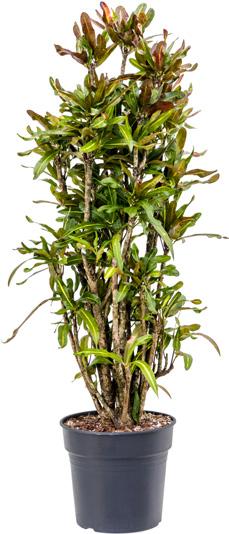

De Codiaeum, beter bekend als Croton, komt voor in Indonesië, Maleisië en India. Het soort heeft opvallend gekleurde bladeren met groen, geel, oranje en rood. De overvloed aan warme tinten in het blad maakt de Croton een absolute blikvanger in het interieur.
Die Codiaeum, besser bekannt als Kroton, kommt in Indonesien, Malaysia und Indien vor. Diese Sorte hat auffällig gefärbte Blätter mit Grün, Gelb, Orange und Rot. Die üppig vorhandenen Warmtöne des Laubs machen den Kroton in Innenräumen zu einem absoluten Blickfang.

The Codiaeum, also known as Croton, is indigenous to Indonesia, Malaysia and India. The species has strikingly coloured leaves with green, yellow, orange and red. The abundance of rich tones in the leaf makes the Croton a true eyecatcher in every interior.





Le Codiaeum, plus connu sous le nom de Croton, est originaire d’Indonésie, de Malaisie et d’Inde. L’espèce a des feuilles aux couleurs frappantes : vert, jaune, orange et rouge. Grâce à l’abondance de tons chauds de ses feuilles, le Croton attire véritablement le regard à l’intérieur.
De Cycas behoort tot de groep palmvarens. Ongeveer 200 miljoen jaar geleden waren deze planten wijdverbreid. Nu zijn er nog enkele soorten over. In het wild komt de Cycas vooral rond de evenaar in Zuidoost-Azië voor.

Die Cycas zählt zur Gattung der Palmfarne. Vor etwa 200 Millionen Jahren waren diese Pflanzen weit verbreitet. Heute sind noch einige Sorten übrig. In freier Natur trifft man die Cycas vor allem im Bereich des Äquators in Südostasien an.






The Cycas belongs to the family of palm ferns. These plants were widespread approximately 200 million years ago. Now only several species remain. The natural habitat of the Cycas is mainly the area of Southeast Asia around the equator.
FR
Le Cycas appartient au groupe des fougères palmées. Il y a environ 200 millions d’années, ces plantes étaient très répandues. Aujourd’hui, il ne reste plus que quelques espèces. À l’état sauvage, le Cycas pousse principalement autour de l’équateur, en Asie du Sud-Est.
De Dicksonia is een boomvaren die van oorsprong in Oost Australie groeit. Deze indrukwekkende varen vraagt wel om kennis over de verzorging. De plant staat het liefst op een vochtige plek met half schaduw, maar kan ook op een zonnige plek staan mits het groeipunt van de stam vochtig gehouden wordt. De grond moet goed gedraineerd zijn zodat de wortels nooit in het water komen te staan.

DE
Die Dicksonia ist ein Baumfarn, dessen Ursprungsgebiet Ostaustralien ist. Die Pflege dieses beeindruckenden Farns erfordert gewisse Kenntnisse. Die Pflanze bevorzugt einen feuchten Standort mit Halbschatten, kann aber auch an einem sonnigen Platz stehen, wenn man darauf achtet, dass der Vegetationspunkt des Stamms feucht bleibt. Der Boden muss gut dräniert sein, denn die Wurzeln dürfen keinesfalls im Wasser stehen.



The Dicksonia is a tree fern originally from eastern Australia. Some prior knowledge is required on how to take care of this impressive fern. The plant prefers a moist, partially shaded spot but can also stand in direct sunlight as long as the growing point of the stem is kept moist. The soil should be drained properly so the roots are never submerged.



Le Dicksonia est une fougère arborescente qui pousse à l’origine dans l’est de l’Australie. Cette fougère impressionnante nécessite cependant des connaissances sur son entretien. La plante préfère un endroit humide et mi-ombragé, mais peut également être placée dans un endroit ensoleillé à condition que le point de croissance de la tige soit maintenu humide. La terre doit être bien drainée pour que les racines ne restent jamais dans l’eau.
De Dieffenbachia is een tropische plant met veelal grote bonte bladeren afkomstig uit het Amazone gebied. Deze plant staat het liefst in vochtige grond, zonder dat de wortels in het water staan. Op een lichte plek zonder direct zonlicht voelt de Dieffenbachia zich het meest thuis.

Die Dieffenbachia ist eine tropische Pflanze mit oftmals großen, bunten Blättern, die aus dem Amazonasgebiet stammt. Diese Pflanze wächst am liebsten auf feuchtem Boden, ohne dass die Wurzeln im Wasser stehen. An einem hellen Standort ohne direkte Sonneneinstrahlung fühlt sich die Dieffenbachia am wohlsten.

The Dieffenbachia is a tropical plant native to the Amazon with mainly large, variegated leaves. This plant prefers moist soil and prefers not to get its roots wet. The Dieffenbachia flourishes in a light place without direct sunlight.





Le Dieffenbachia est une plante tropicale à grandes feuilles panachées originaire de la région amazonienne. Cette plante préfère une terre humide, sans que les racines restent dans l’eau. Le Dieffenbachia préfère un endroit lumineux, sans lumière directe du soleil.



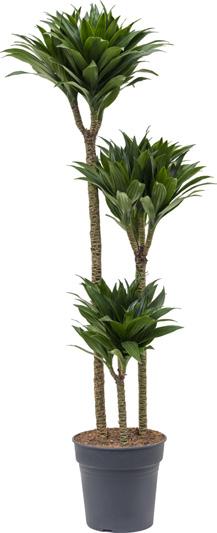
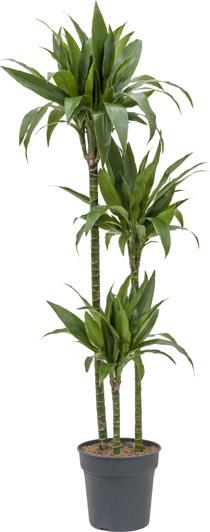
De Dracaena komt voornamelijk voor in Afrika en nabijgelegen eilanden, maar ook in tropische gebieden van Azië en Midden-Amerika. Het is een uitgebreide groep waarvan de meeste soorten op een rechte stam groeien. De bladeren zijn donkergroen met soms gele accenten. De plant is gemakkelijk in onderhoud en hierdoor ook ideaal voor kantoorbeplanting.

Die Dracaena ist vor allem in Afrika und auf nahegelegenen Inseln anzutreffen, doch man findet sie auch in den tropischen Gebieten Asiens und Mittelamerikas. Es ist eine umfangreiche Gattung; die meisten Sorten wachsen mit geradem Stamm. Die Blätter sind dunkelgrün und haben manchmal gelbe Akzente. Die Pflanze ist pflegeleicht und dadurch auch ideal für die Bürobegrünung geeignet.

Dracaena primarily grow in Africa and nearby islands, but also in the tropical areas of Asia and Central America. This is a large group and most varieties grow on a straight trunk. The leaves are dark green and sometimes have yellow accents. This plant species is easy to care for and ideal for use in offices.

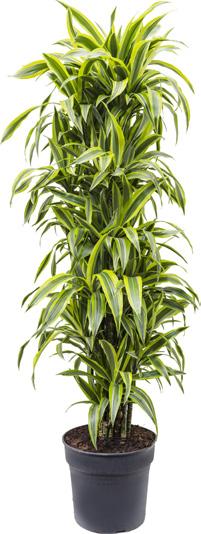
Le Dracaena pousse principalement en Afrique et dans les îles voisines, mais aussi dans les régions tropicales d’Asie et d’Amérique centrale. Il s’agit d’un vaste groupe dont la plupart des espèces poussent sur une tige droite. Les feuilles sont vert foncé avec parfois des accents jaunes. Cette plante est facile à entretenir et est donc idéale pour les plantations dans les bureaux.




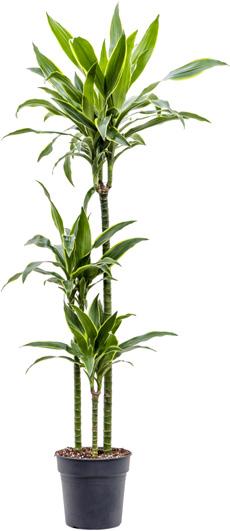





De Ficus komt voornamelijk voor in Azië, Afrika en Zuid-Amerika, maar ook in delen van Australië en het Middellandse-Zeegebied. Het is een uitgebreide groep met uiteenlopende kenmerken. De Ficus lyrata heeft prachtige grote bladeren en de Ficus microcarpa heeft hele kleine bladeren, sommige soorten worden gekweekt als bonsai en andere met gevlochten stam.







Die Ficus kommt hauptsächlich in Asien, Afrika und Südamerika, jedoch auch in Teilen Australiens sowie im Mittelmeerraum vor. Es ist eine umfangreiche Gattung mit vielerlei Merkmalen. Die Ficus lyrata besitzt prachtvolle große Blätter, während die Blätter der Ficus microcarpa winzig klein sind; einige Arten werden als Bonsai gezüchtet, andere mit geflochtenem Stamm.
The Ficus mainly grows in Asia, Africa and South America but also in parts of Australia and the Mediterranean. This is a large group with different characteristics. The Ficus lyrata has big, beautiful leaves and the Ficus microcarpa has very small leaves. Some varieties are grown as bonsais and others with a braided stem.
Le ficus pousse principalement en Asie, en Afrique et en Amérique du Sud, mais aussi dans certaines parties de l’Australie et de la Méditerranée. Il s’agit d’un vaste groupe aux caractéristiques diverses. Le Ficus lyrata a de belles grandes feuilles et le Ficus microcarpa a de très petites feuilles, certaines espèces sont cultivées comme des bonsaïs et d’autres avec des troncs tressés.








De Licuala behoort tot de groep waaierpalmen. Het is een grandioze plant vanwege zijn enorme bladeren. Het soort komt oorspronkelijk voor in de tropische bossen van Zuidoost-Azië, China, Nieuw-Guinea en de eilanden in de westelijke stille Oceaan. De plant stelt hoge eisen aan de lichtintensiteit en luchtvochtigheid.

Die Licuala zählt zur Gattung der Strahlenpalmen. Mit ihren gewaltigen Blättern ist es eine grandiose Pflanze. Ursprüngliche Heimat dieser Sorte sind die Tropenwälder Südostasiens, Chinas, Neuguineas und der Inseln im westlichen Pazifik. Die Pflanze stellt hohe Anforderungen an Lichtintensität und Luftfeuchtigkeit.


The Licuala belongs to the family of fan palms. This magnificent plant is known for its gigantic leaves. The variety occurs in the tropical forests of Southeast Asia, China, New Guinea and the islands in the western Pacific. This plant is very demanding, in terms of light intensity and humidity.




Le Licuala appartient au groupe des palmiers cuillères. C’est une plante grandiose en raison de ses énormes feuilles. L’espèce est originaire des forêts tropicales d’Asie du Sud-Est, de Chine, de Nouvelle-Guinée et des îles du Pacifique occidental. La plante est très exigeante en matière d’intensité lumineuse et d’humidité.
De Liriope is een grasachtige plant die van oorsprong uit Oost en Zuidoost Azië komt. Het is een laagblijvende plant die in het najaar opvallende, mooie bloemen kan geven. De Liriope is goed bestand tegen vorst waardoor deze niet alleen als interieurplant geschikt is, maar ook voor tuin en terras.
Die Liriope ist eine Graspflanze, die ursprünglich aus Ost- und Südostasien stammt. Es handelt sich um ein kleinwüchsiges Gewächs, das im Herbst auffällige, schöne Blüten bilden kann. Die Liriope besitzt eine gute Frostbeständigkeit und eignet sich damit nicht nur als Zimmerpflanze, sondern auch für Terrasse und Garten.
The Liriope is a grass-like, flowering plant originally from East and Southeast Asia. The plant is a low-growing plant that gives eye-catching flowers in autumn. The Liriope is resistant to frost, making it not only suitable as an indoor plant but also for your garden or terrace.

Le Liriope est une plante herbacée originaire d’Asie de l’Est et du Sud-Est. Il s’agit d’une plante à faible croissance qui peut produire de belles hampes de fleurs à l’automne. Le Liriope est très résistant au gel : il convient donc non seulement comme plante d’intérieur, mais aussi pour le jardin et la terrasse.





De Monstera, ook bekend als gatenplant, is een kruipende klimplant die voornamelijk voorkomt in de tropische regenwouden van zuidelijk Mexico en Panama. In het wild klimmen de planten tot wel 20 meter hoog in bomen of tegen rotsen. De plant is zeer geliefd in het interieur vanwege zijn tropische uitstraling en zeer makkelijk te verzorgen.
Die Monstera, auch unter dem Namen Fensterblatt bekannt, ist eine Kriech- und Kletterpflanze, die hauptsächlich in den tropischen Regenwäldern von Südmexiko und Panama angesiedelt ist. In freier Natur wachsen die Pflanzen an Bäumen oder Felsen bis zu 20 Meter in die Höhe. Die Pflanze ist für Innenräume sehr beliebt, weil sie eine tropische Ausstrahlung besitzt und leicht zu pflegen ist.

The Monstera, also known as a cheese plant, is a climber plant that mainly lives in the tropical rainforests of South Mexico and Panama. These plants can climb up to 20 metres high on trees or rocks in the wild. The plant is a beloved feature of any interior thanks to its tropical look and is very easy to care for.



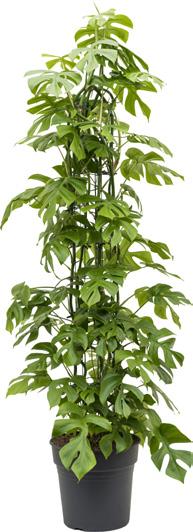



Le Monstera, aussi connu sous le nom de plante à trous, est une plante grimpante rampante qui pousse principalement dans les forêts tropicales humides du sud du Mexique et du Panama. Dans la nature, les plantes grimpent jusqu’à 20 mètres de haut dans les arbres ou contre des rochers. Cette plante est très appréciée dans les intérieurs en raison de son aspect tropical et de sa facilité d’entretien.


De Musa, beter bekend als bananenboom, komt van oorsprong uit de tropische regenwouden van Zuidoost-Azië. Er zijn wereldwijd ongeveer 400 soorten. De Cavendish wordt het meest gebruikt voor in het interieur. Met zijn grote groene bladeren zorgt de Musa voor een tropische uitstraling in het interieur.

Die Musa, besser bekannt als Bananenbaum, hat ihren Ursprung in den tropischen Regenwäldern Südostasiens. Es gibt weltweit ungefähr 400 Sorten. Für Innenräume wählt man zumeist die Cavendish. Mit ihren großen grünen Blättern sorgt diese Palme für eine tropische Stimmung im Raum.



The Musa, also known as the banana tree, is originally found in the tropical rainforests of Southeast Asia. There are approximately 400 varieties worldwide. The Cavendish is most often used in interiors. With its large, green leaves, the Musa creates a tropical look in your interior.

Le Musa, plus connu sous le nom de bananier, provient des forêts tropicales d’Asie du Sud-Est. Il en existe environ 400 sortes dans le monde. Le Cavendish est le plus souvent utilisé à l’intérieur. Avec ses grandes feuilles vertes, le Musa donne un aspect tropical à l’intérieur.
De Pandanus of schroefpalm groeit in de tropen van Zuid-Oost Azië en Oceanië. De bladeren van de boom zijn per drie spiraalvormig gerangschikt en doen denken aan een Yucca, maar door de vele propwortels rondom de stam lijkt de boom ook op een Mangrove. Deze tropische blikvanger voelt zich het lekkerst in een warme, halfschaduwrijke omgeving met een hoge luchtvochtigheid. Zorg daarom voor een altijd licht vochtig grond.







Die Pandanus, auch Schraubenpalme genannt, wächst in den Tropen Südostasiens und Ozeaniens. Die Blätter des Baumes sind in drei Spiralen angeordnet und erinnern an eine Yucca, aber durch die vielen Stützwurzeln um den Stamm herum ähnelt der Baum auch einer Mangrove. Dieser tropische Hingucker fühlt sich in einer warmen, halbschattigen Umgebung mit hoher Luftfeuchtigkeit am wohlsten. Achten Sie deshalb darauf, dass die Erde immer leicht feucht ist.
The Pandanus or screw palm grows in the tropics of South-East Asia and Oceania. The tree leaves are arranged in three spirals and are reminiscent of a Yucca. It also resembles a Mangrove because of the many prop roots around the trunk. This tropical eye-catcher feels best in a warm, semi-shaded environment with high humidity. So ensure that the soil is always slightly moist.
Le Pandanus ou palmier à vis pousse sous les tropiques d’Asie du Sud-Est et d’Océanie. Les feuilles de l’arbre sont disposées spirales par trois et rappellent un yucca. Mais l’arbre ressemble également à une mangrove en raison des nombreuses racines qui entourent le tronc. Cette plante tropicale qui ne passera pas innaperçue se sent mieux dans un environnement chaud et semi-ombragé, avec une humidité élevée. Veillez donc à ce que le sol soit toujours légèrement humide.









De Philodendron komt voor in de tropische regenwouden van Midden- en Zuid-Amerika. Het is een grote groep, waarvan veel soorten in hoge bomen klimmen om voldoende licht te krijgen. Er zijn zelfs soorten die nooit op de grond leven, maar ontkiemen hoog in de boom en daar hun hele leven blijven. De Philodendron is een sterke plant die het prima doet in het interieur.
Die Philodendron kommt in den tropischen Regenwäldern Mittelund Südamerikas vor. Die Gattung zählt viele Arten, und zahlreiche Sorten wachsen an hohen Bäumen empor, damit sie ausreichend Licht erhalten. Es gibt sogar Sorten, die überhaupt nicht am Boden wachsen, sondern im Baumwipfel keimen und dort ihr ganzes Pflanzenleben verbringen. Die Philodendron ist eine robuste Pflanze mit schöner Wirkung im Innenbereich.
The Philodendron grows in the tropical rainforests of Central and South America. It is a large group with many types that climb on high trees to get plenty of sunlight. There are even types that never live on the ground but germinate high up in trees and stay there their entire lives. The Philodendron is a strong plant that thrives indoors.
Le philodendron pousse dans les forêts tropicales humides d’Amérique centrale et du Sud. Il s’agit d’un grand groupe, dont de nombreuses espèces grimpent sur de hauts arbres pour obtenir suffisamment de lumière. Il existe même des espèces qui ne vivent jamais sur le sol, mais qui germent en haut de l’arbre et y restent toute leur vie. Le Philodendron est une plante robuste qui s’adapte bien à l’intérieur."











De Platycerium komt van oorsprong uit de tropische oerwouden van Australie. Deze epifiet groeit hier op bomen en heeft geweivormige, zachte bladeren. De onderste bladeren van de plant zijn bruin en functioneren als bescherming van de wortels. De Platycerium staat graag op een lichte plek zonder direct zonlicht. De grond waar de plant in staat is vochtig, maar niet nat.



Die Platycerium stammt ursprünglich aus den tropischen Urwäldern von Australien. Sie wächst hier epiphytisch an Bäumen und hat weiche, geweihförmige Blätter. Die unteren Blätter der Pflanze sind braun und schützen die Wurzeln. Die Platycerium steht gerne an einem hellen Ort ohne direktes Sonnenlicht. Der Boden, auf dem die Pflanze steht, soll feucht, aber nicht nass sein.

The Platycerium is originally from the tropical forests of Australia. This epiphyte grows here on trees and has leaves that are antler-shaped and soft. The plant’s bottom leaves are brown and serve to protect the roots. The Platycerium enjoys a light spot out of direct sunlight. The plant should be planted in moist but not overly wet soil.



Le Platycerium est originaire des forêts tropicales d’Australie. Cet épiphyte y pousse sur les arbres et a des feuilles souples en forme de bois de cerf. Les feuilles inférieures de la plante sont brunes et servent de protection aux racines. Le Platycerium apprécie un endroit lumineux, sans lumière directe du soleil. La terre dans laquelle se trouve la plante est humide, mais pas mouillée.



De Pleomele komt oorspronkelijk uit Mozambique, Madagaskar, Mauritius en andere nabijgelegen eilanden in de Indische Oceaan. De grillige takken geven de plant een natuurlijk karakter. Het is een zeer sterk soort dat uitstekend geschikt is voor kantoorbeplanting.

Die Pleomele hat ihren Ursprung in Mosambik und auf Madagaskar, Mauritius sowie anderen nahegelegenen Inseln im Indischen Ozean. Die unregelmäßig geformten Zweige geben der Pflanze ein natürliches Aussehen. Diese Sorte ist sehr robust und dadurch ausgezeichnet für die Bürobegrünung geeignet.


The Pleomele is originally from Mozambique, Madagascar, Mauritius and other nearby islands in the Pacific. The quirky branches give the plant a natural look. It is a very robust species that is highly suitable for offices.
Le Pleomele est originaire du Mozambique, de Madagascar, de l’île Maurice et d’autres îles proches dans l’océan Indien. Les branches biscornues donnent un caractère naturel à la plante. Il s’agit d’une espèce très solide convenant parfaitement pour les plantations de bureaux.
Origin Mozambique and Madagascar Family Asparagaceae


De Podocarpus macrophyllus komt oorspronkelijk uit bergachtige gebieden in China en Japan. Hier groeit de plant in het koele, vochtige klimaat. De Podocarpus kan zowel in kantoren als in onverwarmde binnenruimtes gehouden worden. De fijne, lancetvormige bladeren geven de plant een fraaie uitstraling.
Die Podocarpus macrophyllus stammt ursprünglich aus Gebirgsgegenden in China und Japan. Hier wächst die Pflanze im kühlen, feuchten Klima. Die Podocarpus kann sowohl in Büros als auch in ungeheizten Innenräumen aufgestellt werden. Die feinen, streifenförmigen Blätter verleihen der Pflanze eine sehr schöne Ausstrahlung.


The Podocarpus macrophyllus is native to the mountainous regions in China and Japan. The plant grows there in a cool, moist climate. The Podocarpus is suitable for both offices and unheated indoor areas. The delicate lanceolate leaves give the plant a stunning appearance.



Le Podocarpus macrophyllus est originaire des zones montagneuses de la Chine et du Japon. La plante y pousse dans un climat frais et humide. Le Podocarpus peut être conservé tant dans des bureaux que dans des pièces non chauffées. Les feuilles fines et lancéolées donnent un aspect attrayant à la plante.
Origin China and Japan
De Rhapis komt oorspronkelijk uit Zuidoost-Azië en delen van China. De palm heeft kenmerkende stammen, die wel iets van bamboe weghebben. De Rhapis heeft weinig licht en water nodig en is daarom uitstekend te gebruiken voor kantoorbeplanting.


Die Rhapis hat ihr Ursprungsgebiet in Südostasien und Teilen Chinas. Das Palmengewächs besitzt charakteristische Stämme, die an Bambus erinnern. Die Rhapis benötigt nur wenig Licht und Wasser und eignet sich daher sehr gut für die Bürobegrünung.


The Rhapis hails from Southeast Asia and parts of China. These palm trees have characteristic trunks that are reminiscent of bamboo. The Rhapis does not need a lot of light and water and is therefore suitable for offices.



Le Rhapis est originaire d’Asie du Sud-Est et de certaines parties de la Chine. Ce palmier a des troncs distinctifs qui ressemblent un peu à des bambous. Le Rhapis a besoin de peu de lumière et d’eau et convient donc parfaitement à des plantations de bureaux.
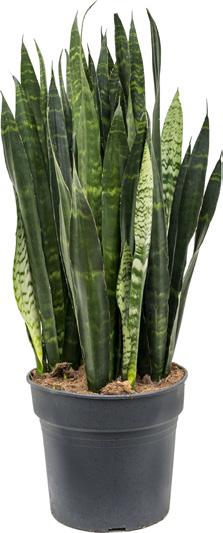
De Sansevieria komt voor in woestijnachtige gebieden van Afrika en Azië. Daar hebben deze planten zich weten aan te passen aan het droge klimaat. De planten hebben kenmerkende bladeren die als stevige punten uit de grond steken. De Sansevieria is gemakkelijk in onderhoud en hierdoor ook ideaal voor kantoorbeplanting.

Die Sansevieria kommt in den Wüstenzonen Afrikas und Asiens vor. Dort haben diese Pflanzen gelernt, sich dem trockenen Klima anzupassen. Ihr charakteristisches Merkmal sind die Blätter, die wie feste Spitzen aus dem Boden ragen. Die Sansevieria ist pflegeleicht und dadurch auch ideal für die Bürobegrünung geeignet.







The Sansevieria grows in desert-like areas in Africa and Asia. The plants were able to adapt to the dry climate in these regions. These plants have characteristic leaves that stick out of the ground like firm tips. The Sansevieria is easy to care for and ideal for use in offices.
Le Sansevieria pousse à l’origine dans les zones désertiques d’Afrique et d’Asie. Ces plantes ont réussi à s’y adapter au climat sec. Les plantes ont des feuilles distinctives qui sortent de la terre comme des pointes solides. Le Sansevieria est facile à entretenir et donc idéal aussi pour les plantations de bureaux.




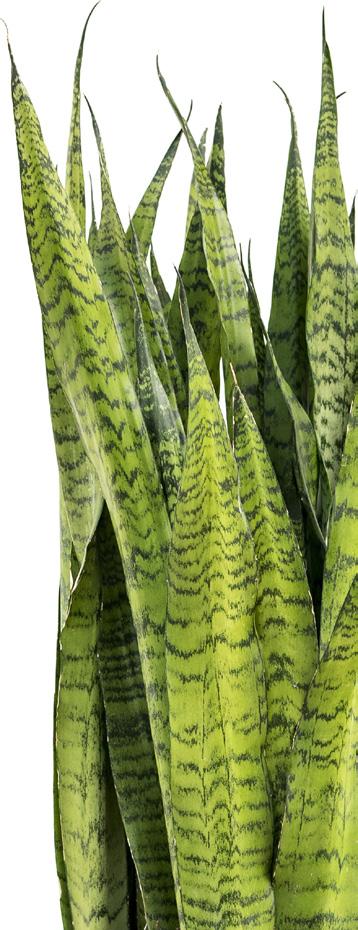




De Satakentia liukiuensis behoort tot de mooiste palmen ter wereld. De soort groeit alleen op de Japanse eilanden Ishigaki Jima en Iriomote Jima, die onderdeel zijn van de Liukiu (Ryukyu) eilanden. Vandaar ook de Latijnse toevoeging 'liukiuensis' wat 'van liukiu' betekent. De Satakentia houdt van warmte, veel licht en hoge luchtvochtigheid en kan 9 tot 10 meter hoog worden.
Die Satakentia liukiuensis ist eine der schönsten Palmen der Welt. Die Art wächst nur auf den japanischen Inseln Ishigaki Jima und Iriomote Jima, die Teil der Liukyu (Ryukyu)-Inseln sind. Daher der lateinische Zusatz „liukiuensis“, was „von Liukyu“ bedeutet. Die Satakentia mag Wärme, viel Licht und hohe Luftfeuchtigkeit und kann eine Höhe von 9 bis 10 Metern erreichen.
The Satakentia liukiuensis is one of the most beautiful palms in the world. The species only grows on the Japanese islands of Ishigaki Jima and Iriomote Jima, which are part of the Liukyu (Ryukyu) Islands. Hence the Latin addition 'liukiuensis' which means 'from liukiu'. The Satakentia likes warmth, a lot of light and high humidity and can reach a height of 9 to 10 meters.







Le Satakentia liukiuensis est l'un des plus beaux palmiers du monde. L'espèce ne pousse que sur les îles japonaises d'Ishigaki-jima et d'Iriomote-jima, qui font partie des îles Liukiu (Ryukyu). D'où le qualificatif latin « liukiuensis » qui signifie « de Liukiu ». Le Satakentia aime la chaleur, beaucoup de lumière ainsi qu'une forte humidité et peut atteindre une hauteur de 9 à 10 mètres.
De Schefflera komt van oorsprong uit Australië en NieuwZeeland, maar groeit inmiddels wereldwijd van de tropen tot in warme gematigde gebieden. Het soort heeft kenmerkende bladeren die lijken op een hand met een paar extra vingers. De Schefflera is een sterke plant zonder al te veel eisen en is daarom zeer geschikt voor kantoorbeplanting.
DE
Die Schefflera stammt ursprünglich aus Australien und Neuseeland, wächst aber inzwischen weltweit, von den Tropen bis in gemäßigt warme Gebiete hinein. Diese Sorte hat charakteristische Blätter, die aussehen wie eine Hand mit einigen zusätzlichen Fingern. Die Schefflera ist eine robuste Pflanze, die keine großen Ansprüche stellt und damit sehr gut für die Bürobegrünung geeignet ist.
The Schefflera is originally from Australia and New Zealand but now grows around the world, from the tropics to warm temperate climates. The species has characteristic leaves that resemble a hand with a few additional fingers. The Schefflera is a strong plant without too may requirements, making it highly suitable for offices.








Le Schefflera est originaire d’Australie et de Nouvelle-Zélande, mais il pousse aujourd’hui dans le monde entier, des tropiques aux régions tempérées chaudes. L’espèce a des feuilles distinctives qui ressemblent à une main avec quelques doigts supplémentaires. Le Schefflera est une plante robuste peu exigeante et convient donc parfaitement aux plantations de bureaux.
De Scindapsus staat ook wel bekend als Epipremnum. De bonte hartvormige bladeren zijn kenmerkend voor de plant, maar er zijn ook varianten met een egale bladkleur. De Scindapsus staat graag in een licht vochtige grond op een lichte plek zonder direct zonlicht en niet op de tocht. Het is een sterke plant die niet gevoelig is voor plantziektes waardoor onderhoud gemakkelijk is.



Die Scindapsus ist auch unter dem Namen Epipremnum bekannt. Die bunten, herzförmigen Blätter sind das charakteristische Merkmal dieser Pflanze; jedoch gibt es auch Arten mit einfarbigen Blättern. Die Scindapsus bevorzugt einen leicht feuchten Boden an einem hellen und zugfreien Standort ohne direkte Sonneneinstrahlung. Es ist eine robuste Pflanze, die unanfällig gegenüber Pflanzenkrankheiten und dadurch sehr pflegeleicht ist.

The Scindapsus is also known as Epipremnum. The variegated heart-shaped leaves are characteristic for the plant but there are also variants with an even leaf colour. The Scindapsus prefers lightly moist soil in a light location away from direct sunlight and draughts. It is a strong plant that is not very susceptible to plant disease, making maintenance easy.


Le Scindapsus est également connu sous le nom d’Epipremnum. Les feuilles panachées en forme de cœur sont caractéristiques de la plante, mais il existe également des variétés dont la couleur des feuilles est uniforme. Le Scindapsus préfère une terre légèrement humide, dans un endroit lumineux, sans lumière directe du soleil et sans courant d’air. C’est une plante robuste qui n’est pas sensible aux maladies des plantes, garantissant un entretien facile.
De Strelitzia komt voor in Zuid-Afrika en heeft dankzij haar prachtige bloemen de bijnaam Bird of Paradise. De meest bekende soorten zijn de Strelitzia reginae en de Strelitzia nicolai. De Strelizia staat het liefst op een zo licht mogelijke plaats en houdt van een vochtige grond, zonder dat de wortels nat staan.





Die Strelitzia kommt in Südafrika vor, wo sie wegen der prachtvollen Blüten den Beinamen "Paradiesvogelblume" trägt. Die bekanntesten Sorten sind Strelitzia reginae und Strelitzia nicolai. Die Strelitzia steht am liebsten an einem möglichst hellen Ort und mag einen feuchten Boden, ohne dass jedoch die Wurzeln der Nässe ausgesetzt sind.

The Strelitzia can be found in South Africa and has been given the nickname Bird of Paradise thanks to its beautiful flowers. The most famous species are the Strelitzia reginae and the Strelitzia nicolai. The Strelitzia prefers a light location and thrives in moist soil as long as its roots are not submerged.
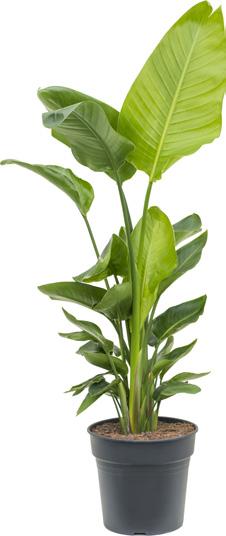
Le Strelitzia pousse à l’origine en Afrique du Sud et, grâce à ses magnifiques fleurs, il est surnommé l’oiseau du paradis. Les espèces les plus connues sont le Strelitzia reginae et le Strelitzia nicolai. Le Strelizia préfère l’endroit le plus lumineux possible et aime une terre humide, sans que les racines soient mouillées.
De Veitchia komt voor in de Filipijnen en op de Pacifische eilanden. Door het tropische uiterlijk wordt de Veitchia veel gebruikt in zwembaden, waar deze plant goed gedijt vanwege een hoge luchtvochtigheid. De palm kan ook gebruikt worden voor kantoorbeplanting op een plek met veel licht en in vochtige grond.
De Veitchia kommt auf den Philippinen und den Pazifikinseln vor. Ihrer tropischen Erscheinung wegen wird die Veitchia oft in Schwimmbädern aufgestellt, wo diese Pflanze wegen der dortigen hohen Luftfeuchtigkeit gut gedeiht. Die Palme kann auch zur Bürobegrünung an Standorten mit viel Licht und auf feuchtem Boden eingesetzt werden.
The Veitchia lives in the Philippines and the islands in the Pacific. Thanks to its tropical look, the Veitchia is often found in swimming pool buildings as this plant thrives in high air humidity. The palm is also suitable in offices in areas with plenty of sunlight and in moist soil.







Le Veitchia pousse à l’origine aux Philippines et dans les îles du Pacifique. En raison de son aspect tropical, le Veitchia est souvent utilisé dans les piscines, où il prospère grâce à une humidité élevée. Le palmier peut également être utilisé pour des plantations de bureaux dans un endroit bien éclairé et dans une terre humide.


De zonminnende Washingtonia robusta groeit oorspronkelijk in Californië en Mexico. De boom die in Nederland ook wel Mexicaanse Waaierpalm wordt genoemd, is door een behoefte aan veel direct zonlicht een echte buitenpalm. De grond van de Washingtonia moet constant vochtig blijven, zonder dat de wortels teveel in het water staan.





Die sonnenliebende Washingtonia robusta wächst ursprünglich in Kalifornien und Mexiko. Der Baum, in den Deutschland auch Mexikanische Fächerpalme genannt, ist eine echte Palme für draußen, da er viel direktes Sonnenlicht benötigt. Der Boden der Washingtonia muss ständig feucht bleiben, ohne dass die Wurzeln zu sehr im Wasser stehen.
The sun-loving Washingtonia robusta originally grows in California and Mexico. The tree, which is also known as the Mexican Fan Palm, is a true outdoor palm because it needs a lot of direct sunlight. The soil of the Washingtonia should remain constantly moist, without the roots being too immersed in water.
Le Washingtonia robusta est une plante qui apprécie le soleil et que l'on retrouve à l'origine en Californie et au Mexique. Comme il a besoin de beaucoup de lumière directe du soleil, l'arbre est un véritable palmier d'extérieur. La terre du Washingtonia doit rester constamment humide, sans que les racines soient trop dans l'eau.
DE
In onze webshop vindt u ons complete assortiment en heeft u direct inzicht in de prijzen en voorraad. Heeft u geen inloggegevens of extra hulp nodig? Neem dan contact met ons op via sales@nieuwkoop-europe.com of +31 885 014 000.

In our web shop you will find our complete assortment and you can directly see the prices and stock. Do you not have login details or do you need some help? Please contact us at sales@nieuwkoop-europe.com or +31 885 014 000.
In unserem Online Shop finden Sie unsere komplette Produktpalette und Sie haben einen direkten Einblick in die Preise sowie unseren Vorrat. Haben Sie noch keine Login oder brauchen Sie Hilfe? Bitte, kontaktieren Sie uns unter sales@nieuwkoop-europe.com oder +31 885 014 000.
FR Dans notre boutique en ligne, vous trouverez notre gamme complète de produits, les stocks et les prix. Voulez-vous faire enregistrer vos données ou avez-vous besoin d’aide ? S’il vous plaît nous contacter à sales@nieuwkoop-europe.com ou +31 885 014 000.
